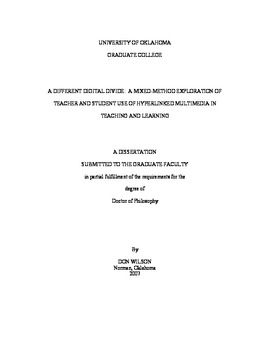| dc.contributor.advisor | McQuarrie, Frank, | en_US |
| dc.contributor.author | Wilson, Don. | en_US |
| dc.date.accessioned | 2013-08-16T12:20:41Z | |
| dc.date.available | 2013-08-16T12:20:41Z | |
| dc.date.issued | 2007 | en_US |
| dc.identifier.uri | https://hdl.handle.net/11244/1207 | |
| dc.description.abstract | The survey consisted of 48 items clustered around the six themes. Teachers were recruited from two southwestern urban districts. Ten teachers and their classes completed the surveys. The class average for each student group was matched to the teacher score on the survey with matched items. The teachers were able to recruit 128 students. | en_US |
| dc.description.abstract | The results of the phenomenological reduction and the quantitative measures indicate that there are differences. The perceptions of the experts suggested that students need teacher guidance to utilize hyperlinks effectively. The paired samples t test indicated that, though there are differences, the only significant difference for this investigation is in the constructed experience thematic area. The results of the paired sample t test yielded a significance of .021 for the constructed experience sub-scale. | en_US |
| dc.description.abstract | What are the differences, if any, in the way teachers utilize the hyperlink to teach and students utilize the hyperlink to learn? This was the focus of the mixed method study of student and teacher use of the Internet. This preliminary study utilized the sequential---exploratory mixed method that included phenomenological reduction for the qualitative portion and surveys of teachers and students for the quantitative portion. This study begins the exploration of the educational use of the innovation associated with multimedia hyperlinks. | en_US |
| dc.description.abstract | The results indicate that the mindset and approach of teachers is central to their approach and utilization of the innovation. Teachers are needed to provide the guidance to students as they develop their own mindsets for the use of the Internet. It is recommended that teachers investigate their beliefs and behaviors as well as those of their students in an action research role. The data derived from the action research could aid in the decision making of teachers in relation to the guidance needed by students. | en_US |
| dc.description.abstract | The phenomenological reduction of interview data from four experts yielded six thematic areas of concentration. The six themes included autonomy, constructed experience, personal experience, implementation issues, mindset and social issues. These six areas became the areas of focus for the online survey of teachers and students. | en_US |
| dc.description.abstract | Another recommendation is that this initial study be reassessed and revised to improve the quality and confidence in the results. Revisions might include rewriting survey items to increase reliability. Changing procedures to increase sample size is also recommended. The results serve to illuminate the differences that exist between students and teachers in the use of the hyperlink in teaching and learning. | en_US |
| dc.format.extent | xii, 113 leaves ; | en_US |
| dc.subject | Education, Curriculum and Instruction. | en_US |
| dc.subject | Education, Technology of. | en_US |
| dc.subject | Internet in education. | en_US |
| dc.subject | Hypertext systems. | en_US |
| dc.title | A different digital divide: A mixed-method exploration of teacher and student use of hyperlinked multimedia in teaching and learning. | en_US |
| dc.type | Thesis | en_US |
| dc.thesis.degree | Ph.D. | en_US |
| dc.thesis.degreeDiscipline | Department of Educational Leadership and Policy Studies | en_US |
| dc.note | Source: Dissertation Abstracts International, Volume: 68-04, Section: A, page: 1316. | en_US |
| dc.note | Adviser: Frank McQuarrie. | en_US |
| ou.identifier | (UMI)AAI3263434 | en_US |
| ou.group | Jeannine Rainbolt College of Education::Department of Educational Leadership and Policy Studies | |
